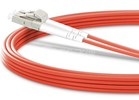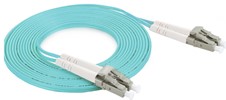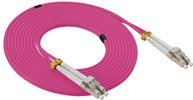
In today's information age, optical fiber communication, as a high-speed, high-bandwidth data transmission mode, has become an important cornerstone of modern communication networks. In fiber optic communication systems, multimode fiber is favored because of its suitability for short-distance transmission and relative low cost. In this article, we will take you through the different standards in multimode fiber, especially OM1, OM2, OM3, OM4 and OM5, to reveal the differences between them and their respective application scenarios. Optical fiber communication refers to the communication method of transmitting data through optical signals, compared with traditional copper cables, optical fiber communication has higher bandwidth, lower transmission...

OM1 multimode fiber
OM1 multimode fiber is one of the first standards to be applied to fiber optic communication systems. With a core diameter of 62.5 microns, it is typically used for short-distance transmissions such as local area networks (LANs) and intranet enterprises. OM1 fibers are based on common LED light sources with short transmission distances and are suitable for low-cost applications.

Core diameter: 62.5 μm
Wavelength: 850 nm (IR range)
Bandwidth: 160 MHz · km
Transfer rate: 1 Gbit/s to 10 Gbit/s
The relatively large core diameter of OM1 fibers limits its bandwidth and transmission rate, so it may perform poorly in scenarios with high requirements for high-speed data transmission. However, in some applications, especially where costs are sensitive, the OM1 is still a suitable choice.
OM1 application scenario
Local Area Network (LAN): Due to its low cost and adequate performance, OM1 multimode fiber is widely used in the local area network of enterprises and organizations to connect various devices and servers.
Fiber-to-the-Desk (FTTD): OM1 fiber is also commonly used in fiber-to-the-desktop deployments to provide high-bandwidth connectivity when fiber needs to be brought into an office or work area.
Although OM1 multimode fiber has advantages in some specific applications, its relatively low bandwidth and transmission rate limit its use in high-speed data transmission environments.
| Multimode Fiber Optic Connectors | Insert Size (Ceramic) | Insertion Loss (dB) |
| SC | φ2.5mm | 0.25~0.5dB |
| LC | φ1.25mm | 0.25~0.5dB |
| FC | φ2.5mm | 0.25~0.5dB |
| ST | φ2.5mm | 0.25~0.5dB |
| MTP/MPO | φ2.5mm | 0.25~0.5dB |
OM2 multimode fiber
OM2 multimode fiber is an upgrade standard in the OM family with an improved core diameter compared to OM1. With a core diameter of 50 microns, OM2 fiber is suitable for short-distance transmission scenarios that require higher bandwidth.

Core diameter: 50 μm
Wavelength: 850 nm (IR range)
Bandwidth: 500 MHz · km
Transfer rate: 1 Gbit/s to 10 Gbit/s
Compared to OM1, OM2 multimode fiber has a smaller core diameter and significantly higher bandwidth, making it more suitable for high-speed data transmission. OM2 fibers also use LED light sources for short-range, medium-rate applications.
| Multimode fiber type | Diameter | Outer sheath color | Optical source, | Bandwidth |
| OM1 | 62.5/125µm | orange | LED | 200MHz*km |
| OM2 | 50/125µm | orange | LED | 500MHz*km |
| OM3 | 50/125µm | Aqua blue | VSCEL | 2000MHz*km |
| OM4 | 50/125µm | Aqua blue | VSCEL | 4700MHz*km |
| OM5 | 50/125µm | Lime green | VSCEL | 28000MHz*km |
Comparison of OM1 vs OM2
Bandwidth: The bandwidth of OM2 is significantly higher than that of OM1 and is suitable for higher rates of data transmission.
Cost: The OM2 is slightly more expensive than the OM1, but it may be more cost-effective in some performance-critical scenarios.
OM2 application scenarios
Enterprise networking: OM2 multimode fiber is often used to connect data centers, servers, and other network equipment within an enterprise to provide higher bandwidth support.
Campus network: University campus networks typically need to handle large amounts of data traffic, and the high bandwidth characteristics of OM2 fiber make it a common choice for campus networks.
OM3 multimode fiber
OM3 multimode fiber represents an important upgrade in the multimode fiber standard to meet the demand for higher speeds and greater bandwidth. The core diameter is also 50 microns, but by employing more advanced technology, OM3 fiber has achieved a significant improvement in transmission performance.

Core diameter: 50 μm
Wavelength: 850 nm (IR range)
Bandwidth: 2000 MHz · km
Transfer rate: 10 Gbit/s to 100 Gbit/s
The bandwidth of OM3 multimode fiber has increased dramatically, making it ideal for supporting higher speed data transmission. In the OM3, a more advanced VCSEL (Vertical Cavity Surface Emitting Laser) light source is used, providing greater flexibility for high-density and high-performance applications such as data centers and enterprise networks.
Comparison of OM2 vs OM3
Bandwidth: The OM3 has a significantly higher bandwidth than the OM2 and supports higher data transfers.
Transmission distance: OM3 can achieve a longer transmission distance at the same data rate.
OM3 application scenarios
Data centers: OM3 multimode fiber excels in high-density environments that connect servers, storage, and networking equipment, supporting high-speed data transmission.
High-performance computing: It is used to connect supercomputers, large-scale data processing clusters, and other scenarios that require high-performance computing.
| Multimode fiber type | Fast Ethernet | 1G Ethernet | 10G Ethernet | 40G Ethernet | 100G Ethernet |
| OM1 | 2000M | 275M | 33M | / | / |
| OM2 | 2000M | 550M | 82M | / | / |
| OM3 | 2000M | 550M | 300M | 100M | 100M |
| OM4 | 2000M | 550M | 550M | 150M | 150M |
| OM5 | / | / | 550M | 440M | 150M |
OM4 multimode fiber
OM4 multimode fiber is an important upgrade in the OM family, which aims to provide solutions with higher bandwidth, longer transmission distances and higher density. By employing optimized materials and design, OM4 multimode fiber offers a significant step forward in performance.

Core diameter: 50 μm
Wavelength: 850 nm (IR range)
Bandwidth: 4700 MHz · km
Transfer rate: 10 Gbit/s to 100 Gbit/s
OM4 multimode fiber offers a further increase in bandwidth, making it the first choice for high-speed data transmission environments. In OM4, an optimized VCSEL light source is used to support higher density connections and is suitable for high-performance applications such as large-scale data centers and cloud computing.
Comparison of OM3 vs OM4
Bandwidth: The OM4 has a significantly higher bandwidth than the OM3 and supports higher data rates, especially in high-density applications.
Transmission distance: OM4 can achieve a longer transmission distance at the same data rate.
OM4 application scenarios
Large-scale data centers: OM4 multimode fiber plays a critical role in high-density data centers that connect a large number of servers and network equipment.
Cloud Computing: Due to its high-bandwidth and high-density connectivity characteristics, OM4 fiber is widely used in applications that support cloud computing and virtualization technologies.
OM5 multimode fiber
OM5 multimode fiber is the latest standard in the OM family and is designed to meet the demand for higher bandwidth and greater flexibility in the field of optical communications in the future. Using wavelength division multiplexing technology, OM5 brings more innovation and application possibilities to optical fiber communication systems.

Core diameter: 50 μm
Wavelength: 850 nm to 953 nm
Bandwidth: 3500 MHz · km
Transfer rate: 40 Gbit/s to 100 Gbit/s
OM5 multimode fiber was introduced primarily to support Wavelength Division Multiplexing, allowing multiple wavelengths to be transmitted on the same fiber, providing a higher total bandwidth. This makes the OM5 ideal for future large-scale data centers and high-performance computing applications.
Comparison of OM4 vs OM5
WDM: The OM5 introduces a wider wavelength range, supporting more wavelengths and providing greater flexibility.
Bandwidth: The OM5 has a slightly higher bandwidth than the OM4, giving it an edge in high-density transmission environments.
OM5 application scenarios
Large-scale cloud service providers: The wavelength division multiplexing features of OM5 multimode fiber make it suitable for connecting data centers of large-scale cloud service providers to meet growing data demands.
5G Communications Base Stations: The high bandwidth and wavelength division multiplexing features of OM5 fiber provide superior performance in base station connections that support 5G communications.
OM1, OM2, OM3, OM4, and OM5 comparisons
| characteristic | OM1 | OM2 | OM3 | OM4 | OM5 |
| Core Diameter (μm) | 62.5 | 50 | 50 | 50 | 50 |
| Wavelength (nm) | 850 | 850 | 850 | 850 | 850 - 953 |
| Bandwidth (MHz · km) | 160 | 500 | 2000 | 4700 | 3500 |
| Transfer Rate (Gbit/s) | 1-10 | 1-10 | 1-100 | 1-100 | 1-100 |
| WDM support | NO | NO | NO | NO | YES |
We took a closer look at the technical specifications, performance characteristics, and application scenarios of OM1, OM2, OM3, OM4, and OM5 multimode fibers. From the basic performance of OM1 to the WDM innovations of OM5, these multimode fiber standards play a unique role in different application scenarios.
In the future, fiber optic technology will continue to evolve to meet the needs of higher bandwidth, greater capacity, and longer transmission distances. WDM, the application of new materials, and the combination with other emerging technologies will be the future development direction of fiber optic technology. In this ever-innovating field, we look forward to seeing more technological breakthroughs and application innovations to push optical communications to new heights.


